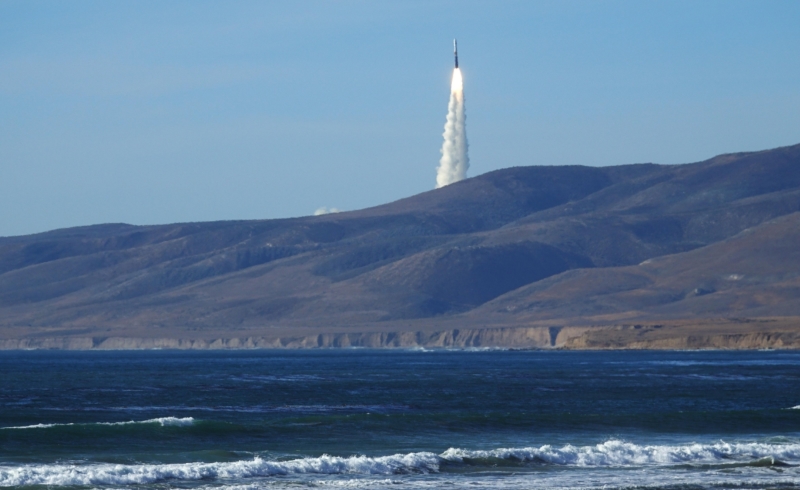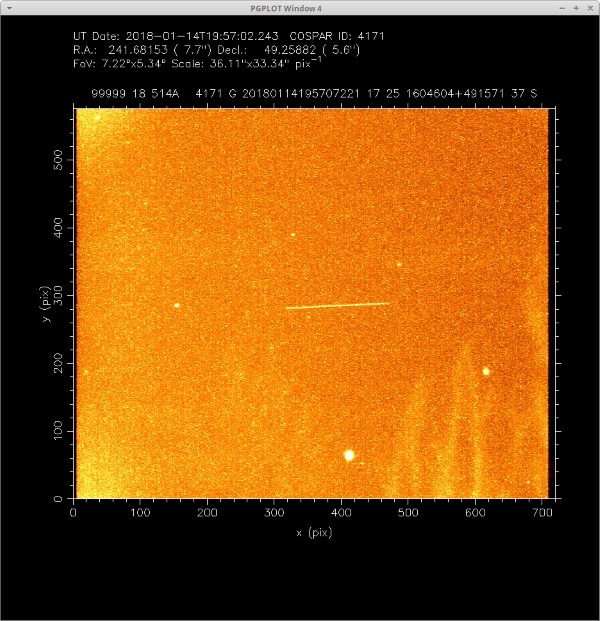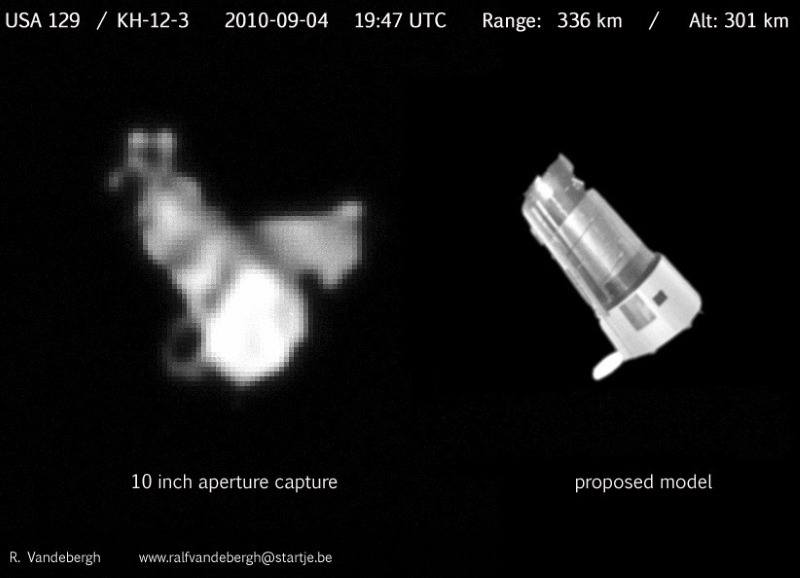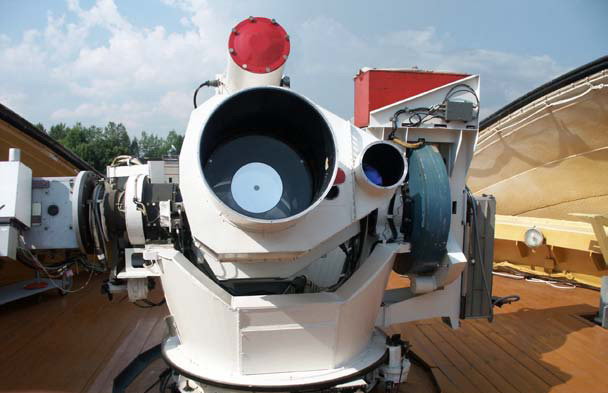How do we learn about secret satellites
A funny and instructive story happened the other day. The American military satellite was launched in secrecy, but just a few hours later, amateur astronomers working in radio and optical ranges found it, refined the orbital parameters, and even with high probability determined its type.

Photo Derrick Stamos / NasaSpaceFlight.com
The Delta-IV launch vehicle with the secret military satellite NROL-47 was launched from the Vandenberg cosmodrome on January 12 at 22:11 UTC (14:11 local time). Already on the first orbit over Europe, the satellite noticed the Cees Bassa (amateur radio astronomer) (Cees Bassa). According to the characteristics of the signal, he determined that the height of the orbit is approximately 1,100 km.

')
After several turns, another enthusiast, Scott Tilley, based on a variety of measurements, specified the parameters of the orbit. Combining their efforts, Scott and Siz got the exact orbit parameters of the secret NROL-47 - 1,048 x 1,057 kilometers with an inclination of 106.00 °. And thanks to this data, Siz discovered the satellite already in the optical range.


Official logo of the mission NROL-47, the image of the National Directorate of Military Space Intelligence of the United States
Certain suspicions about the type of satellite launched were before the launch. The approximate azimuth of the injection was known for the zones of incidence of the spent stages - the apparatus went to a retrograde (against the Earth's rotation) orbit. The combination of a specific modification of the launch vehicle and the inclination of the orbit suggested that the NROL-47 refers to radar reconnaissance satellites, built using the FIA program (Future Imaging Architecture). Thanks to information leaks from Edward Snowden, we know that the satellites are called Topaz. At the same time, the azimuth of the injection was slightly different - before, such devices were displayed at 123 °, and now the areas of incidence prompted the azimuth around 109 °. But the analysis of the orbit and characteristics of the signal from the satellite so far confirms Topaz’s hypothesis. The difference in inclination is most likely due to the fact that the already existing group of four vehicles operates in the range from 54 ° north latitude to 54 ° south latitude, where the main zones of activity are located, and the NROL-47 will operate one from 74 ° north latitude up to 74 ° south, covering less populated areas. A similar pattern was in the American reconnaissance satellites Lacrosse / Onyx - three worked in mid-latitudes and two in higher latitudes.
The ability to accurately determine the orbit of secret satellites is not the limit. There are enthusiasts who manage to photograph devices in orbit, allowing us to see their design. Probably the most famous case here is the photographs of the American optical intelligence satellites Key Hole KH-11/12 by Dutch amateur astronomer Ralph Vandebergh ( Ralf Vandebergh ). Ralph's passion is to shoot high-quality spacecraft in orbit, he photographed the ISS, transport and cargo ships, upper stages of rockets and satellites. It is to him that we are obliged, for example, to photograph Phobos-Grunt in orbit. And he filmed the USA-129 secret satellite from a distance of 336 kilometers.

Photo by Ralf Vandebergh
After some time, he photographed the same satellite in less fortunate conditions, but from a different angle, which made it possible to confirm its intended appearance.

Photo by Ralf Vandebergh
Separately, it is worth noting that developed countries are building space control centers, which are also used to monitor the secret vehicles of other countries. Radar and optical systems allow you to find out the size and shape of the satellite and see it with a quality inaccessible to lovers. For example, the laser rangefinder of the Russian system "Sazhen-T" allows you to receive the parameters of the satellite orbit with an accuracy of two centimeters. But, alas, for ordinary people, this data is also a secret.

“Sazhen-T”, photo by KIK of the USSR
Enthusiasts, listening and photographing satellites, we have. In the radio band, probably the most famous is Dmitry Pashkov ( R4UAB ). He listened and published signals from the Russian military satellite inspector Kosmos-2499 .
While technological progress is moving forward, the technology becomes obsolete, and someday we will be able to admire the published technical solutions that were used on the now secret satellites. But for now, we can look into the mystery thanks to space enthusiasts, for which we thank them so much.

Photo Derrick Stamos / NasaSpaceFlight.com
The Delta-IV launch vehicle with the secret military satellite NROL-47 was launched from the Vandenberg cosmodrome on January 12 at 22:11 UTC (14:11 local time). Already on the first orbit over Europe, the satellite noticed the Cees Bassa (amateur radio astronomer) (Cees Bassa). According to the characteristics of the signal, he determined that the height of the orbit is approximately 1,100 km.

')
After several turns, another enthusiast, Scott Tilley, based on a variety of measurements, specified the parameters of the orbit. Combining their efforts, Scott and Siz got the exact orbit parameters of the secret NROL-47 - 1,048 x 1,057 kilometers with an inclination of 106.00 °. And thanks to this data, Siz discovered the satellite already in the optical range.

Open type

Official logo of the mission NROL-47, the image of the National Directorate of Military Space Intelligence of the United States
Certain suspicions about the type of satellite launched were before the launch. The approximate azimuth of the injection was known for the zones of incidence of the spent stages - the apparatus went to a retrograde (against the Earth's rotation) orbit. The combination of a specific modification of the launch vehicle and the inclination of the orbit suggested that the NROL-47 refers to radar reconnaissance satellites, built using the FIA program (Future Imaging Architecture). Thanks to information leaks from Edward Snowden, we know that the satellites are called Topaz. At the same time, the azimuth of the injection was slightly different - before, such devices were displayed at 123 °, and now the areas of incidence prompted the azimuth around 109 °. But the analysis of the orbit and characteristics of the signal from the satellite so far confirms Topaz’s hypothesis. The difference in inclination is most likely due to the fact that the already existing group of four vehicles operates in the range from 54 ° north latitude to 54 ° south latitude, where the main zones of activity are located, and the NROL-47 will operate one from 74 ° north latitude up to 74 ° south, covering less populated areas. A similar pattern was in the American reconnaissance satellites Lacrosse / Onyx - three worked in mid-latitudes and two in higher latitudes.
Show me your face
The ability to accurately determine the orbit of secret satellites is not the limit. There are enthusiasts who manage to photograph devices in orbit, allowing us to see their design. Probably the most famous case here is the photographs of the American optical intelligence satellites Key Hole KH-11/12 by Dutch amateur astronomer Ralph Vandebergh ( Ralf Vandebergh ). Ralph's passion is to shoot high-quality spacecraft in orbit, he photographed the ISS, transport and cargo ships, upper stages of rockets and satellites. It is to him that we are obliged, for example, to photograph Phobos-Grunt in orbit. And he filmed the USA-129 secret satellite from a distance of 336 kilometers.

Photo by Ralf Vandebergh
After some time, he photographed the same satellite in less fortunate conditions, but from a different angle, which made it possible to confirm its intended appearance.

Photo by Ralf Vandebergh
There are more, but will not show
Separately, it is worth noting that developed countries are building space control centers, which are also used to monitor the secret vehicles of other countries. Radar and optical systems allow you to find out the size and shape of the satellite and see it with a quality inaccessible to lovers. For example, the laser rangefinder of the Russian system "Sazhen-T" allows you to receive the parameters of the satellite orbit with an accuracy of two centimeters. But, alas, for ordinary people, this data is also a secret.

“Sazhen-T”, photo by KIK of the USSR
In his own country
Enthusiasts, listening and photographing satellites, we have. In the radio band, probably the most famous is Dmitry Pashkov ( R4UAB ). He listened and published signals from the Russian military satellite inspector Kosmos-2499 .
Conclusion
While technological progress is moving forward, the technology becomes obsolete, and someday we will be able to admire the published technical solutions that were used on the now secret satellites. But for now, we can look into the mystery thanks to space enthusiasts, for which we thank them so much.
Source: https://habr.com/ru/post/371189/
All Articles